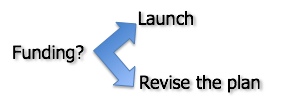Every startup has its own natural level of startup costs. It’s built into the circumstances, like strategy, location, and resources. Call it the natural startup level; or maybe the sweet spot.
1. The Plan
For example, Mabel’s Thai restaurant in San Francisco is going to need about $950,000, while Ralph’s new catering business needs only about $50,000.  The level is determined by factors like strategy, scope, founders’ objectives, location, and so forth. Let’s call it its natural level. That natural startup level is built into the nature of the business, something like DNA.
The level is determined by factors like strategy, scope, founders’ objectives, location, and so forth. Let’s call it its natural level. That natural startup level is built into the nature of the business, something like DNA.
Startup cost estimates have three parts: a list of expenses, a list of assets needed, and an initial cash number calculated to cover the company through the early months when most startups are still too young to generate sufficient revenue to cover their monthly costs.
It’s not just a matter of industry type or best practices; strategy, resources, and location make huge differences. The fact that it’s a Vietnamese restaurant or a graphic arts business or a retail shoe store doesn’t determine the natural startup level, by itself. A lot depends on where, by whom, with what strategy, and what resources.
While we don’t know it for sure ever — because even after we count the actual costs, we can always second-guess our actual spending — I do believe we can understand something like natural levels, somehow related to the nature of the specific startup.
Marketing strategy, just as an example, might make a huge difference. The company planning to buy Web traffic will naturally spend much more in its early months than the company planning to depend on viral word of mouth. It’s in the plan.
So too with location, product development strategy, management team and compensation, lots of different factors. They’re all in the plan. They result in our natural startup level.
2. Funding or Not Funding

There’s an obvious relationship between the amount of money needed and whether or not there’s funding, and where and how you seek that funding. It’s not random, it’s related to the plan itself. Here again is the idea of a natural level, of a fit between the nature of the business startup, and its funding strategy.
It seems that you start with your own resources, and if that’s enough, you stop there too. You look at what you can borrow. And you deal with realities of friends and family (limited for most people), angel investment (for more money, but also limited by realities of investor needs, payoffs, etc.), and venture capital (available for only a few very high-end plans, with good teams, defensible markets, scalability, etc.).
3. Launch or Revise
Somewhere in this process is a sense of scale and reality. If the natural startup cost is $2 million but you don’t have a proven team and a strong plan, then you don’t just raise less money, and you don’t just make do with less. No — and this is important — at that point, you have to revise your plan. You don’t just go blindly on spending money (and probably dumping it down the drain) if the money raised, or the money raisable, doesn’t match the amount the plan requires.
Revise the plan. Lower your sites. Narrow your market. Slow your projected growth rate.
Bring in a stronger team. New partners? More experienced people? Maybe a different ownership structure will help.
What’s really important is you have to jump out of a flawed assumption set and revise the plan. I’ve seen this too often: you do the plan, set the amounts, fail the funding, and then just keep going, but without the needed funding.
And that’s just not likely to work. And, more important, it is likely to cause you to fail, and lose money while you’re doing it.
Repetition for emphasis: you revise the plan to give it a different natural need level. You don’t just make do with less. You also do less.




Comments
[…] (Note: reposted from Planning Startups Stories) […]
[…] you need. It’s not a random number, and it’s not how much you like. You look for the startup sweet spot, as set by the business […]
[…] investment a matter of what the owners ultimately want. And there is what I’ve called the Startup Sweet Spot, the natural right level of financing for the startup, based on what it actually needs to develop […]
[…] Steps to the Startup Sweet Spot By Derek Rowley 3 Steps to the Startup Sweet Spot. Tim Berry, founder of Business Plan Pro software posted this blog entry: Every startup has its […]
Good advice, simply written and well executed. Exactly what all new businesses need
Thanks Tim. Your post really captures what I’ve been learning as I build out my business plan for my bakery. We’re hitting two big decision points for our plan — funding (as you mentioned) and location. Each site we evaluate causes a complete re-work of our plan, which drives start up costs, which drives funding, which could cause another re-think as well.
The process can be frustrating at times but each revision brings us closer to launching.